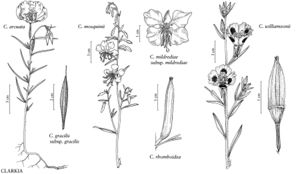Clarkia mosquinii
Canad. J. Bot. 49: 1216, fig. 4A,B. 1971.
Stems erect, to 100 cm, puberulent. Leaves: petiole 10–30 mm; blade linear-lanceolate to ovate or elliptic, 2–5 cm. Inflorescences open racemes, axis recurved only at tip in bud, straight 4+ nodes distal to open flowers; buds pendent, narrowly obovoid, tip obtuse. Flowers: floral-tube 2–5 mm; sepals reflexed individually; corolla rotate, petals lavender-purple, often with darker spots, ± rhombic, unlobed, 10–20 × 6–13 mm, length 1.5–2 times width; stamens 8, subequal, subtended by ciliate scales, pollen blue-gray; ovary shallowly 4-grooved; stigma exserted beyond anthers. Capsules 15–25 mm; pedicel 0–3 mm. Seeds brown or gray, 0.9–1.2 mm, scaly. 2n = 12.
Phenology: Flowering Jun–Jul.
Habitat: Yellow-pine forests.
Elevation: 200–300 m.
Discussion
Clarkia mosquinii is known only from a small area in the Feather River drainage at the northern limits of the Sierra Nevada range in Butte and (barely) Plumas counties; it is listed as rare by the California Native Plant Society.
Clarkia mosquinii is closely related to C. borealis and may be a derivative of that species with a reduced chromosome number. In addition to chromosome number, they differ in geographical distribution and shape of the buds, which are blunt at the tip in C. mosquinii and acute or acuminate in C. borealis. Clarkia mosquinii is also closely related, and probably ancestral, to two species with 2n = 10, C. australis and C. virgata, which have more southern distributions.
Selected References
None.
